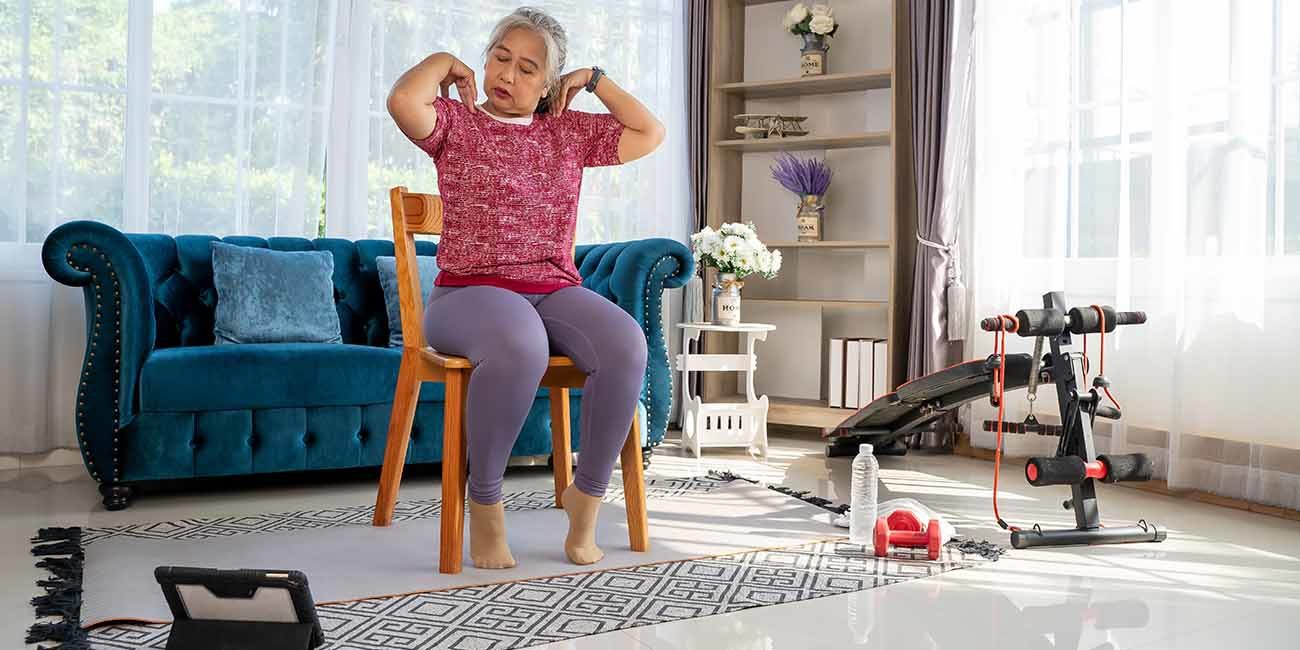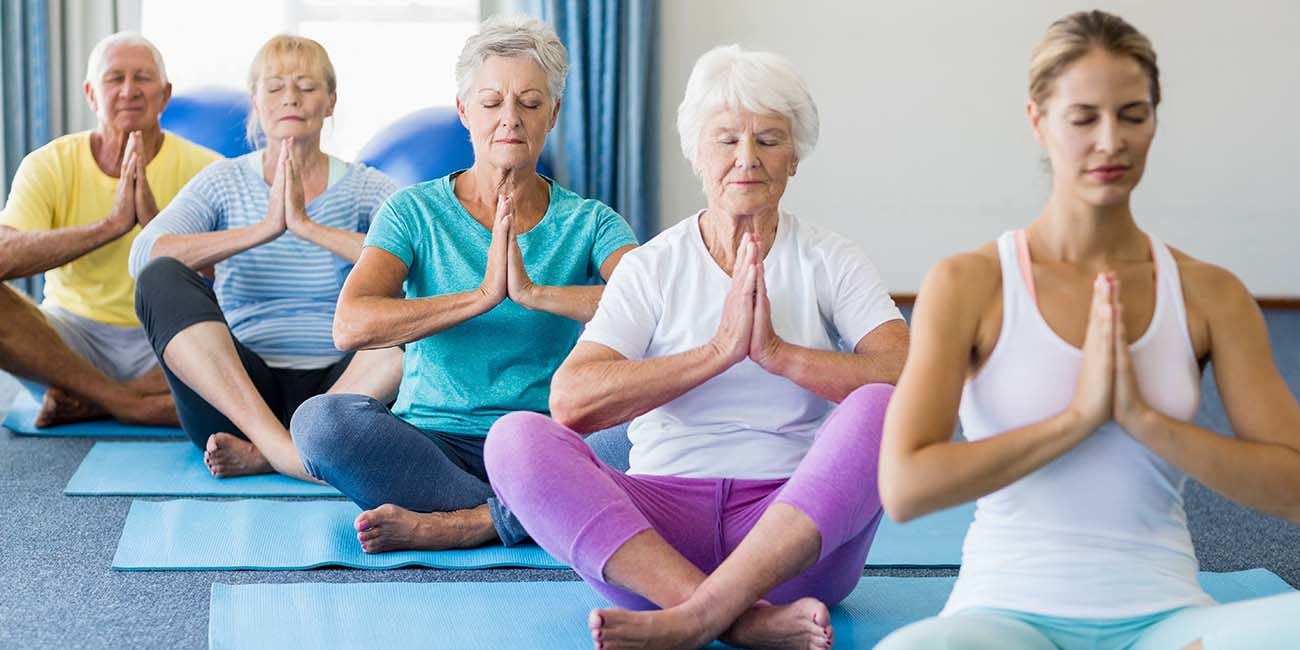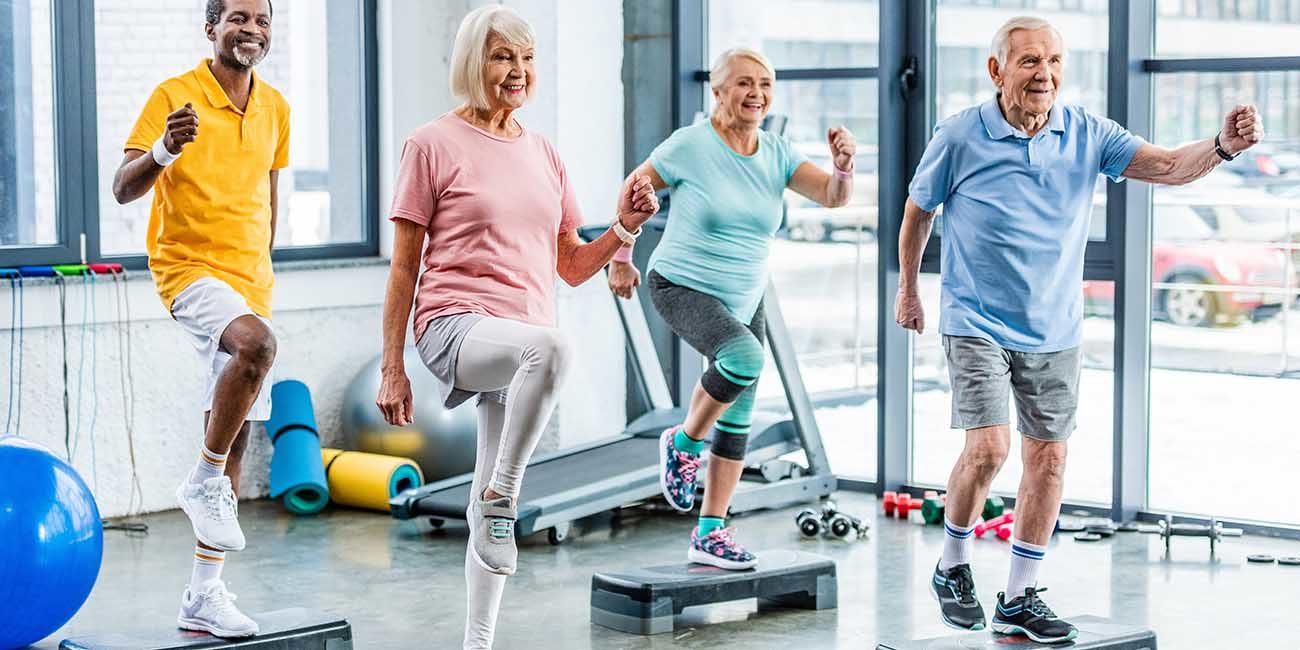Maintaining an active lifestyle is an integral part of staying healthy; when combined with a good diet and adequate sleep, physical activity is one of the most effective ways to boost a person’s chances of living a long and healthy life.
Physical activity becomes even more necessary as someone ages. When people reach their 60s and 70s, doing the same physical activities they did in their 20s and 30s is not a good idea. It is essential to select senior citizen exercises and activities that are healthy, enjoyable, and safe.
The National Institutes of Health (NIH) recommends that senior citizens participate in activities that address their balance, endurance, flexibility, and strength, critical aspects of their health.


Best Balance and Coordination Exercises for Older Adults
- Tightrope Walk
The tightrope walk is a highly recommended exercise to improve balance, posture, and core strength. It is also a relatively simple exercise for seniors.
Instructions:
This exercise does not need any equipment. Seniors only need to extend their arms straight out from their sides, parallel to the floor. Then, walk in a straight line, pausing every time they lift a foot off the ground for one to two seconds.
To keep their head straight and balanced, the person exercising must concentrate on a distant object. Before going on to the next exercise, seniors should complete 15 to 20 steps with these instructions.
It is best to complete the tightrope walk with supervision. Doing so allows you or the other person monitoring your senior loved one to keep track of how many steps they take. You can also serve as a source of motivation if they feel unmotivated and are considering giving up the activity.
- Balancing Wand
The balancing wand is an excellent choice for a balance workout that does not require many resources or techniques. A cane, umbrella, or broom can be used for this activity, and it can be done in a seated position.
Instructions:
Older adults need to hold the bottom of the item they have chosen firmly in the palm of their hand. If they have selected a broom, they need to remove the broom head before beginning. The goal is to hold the stick for as long as possible; people doing this exercise should not focus too much on one side; they must alternate their hands from time to time to balance both sides of their bodies evenly.
- Heel Raises
A heel raise is the last physical exercise we recommend for improving stability. It helps to strengthen the ankle and knee joints, resulting in a more stable gait. If possible, seniors should do this activity while sitting in a chair to improve their balance. If they want to increase the intensity, they can also utilize a hand weight.
Instructions:
A senior should stand up straight with their feet hip-width apart, and they may also place their hands on the sides to gain balance for the first few minutes. Next, both heels are elevated such that they are balancing using the balls of their feet. Then, they must slowly lower themselves to the ground and repeat the process at least ten times. This exercise should be completed while sitting in a chair first and then graduated to a standing position with a nearby handhold for safety.


Best Aerobic Exercises for Older Adults to Improve Endurance
- Brisk Walking
Although brisk walking is a less intensive aerobic exercise than jogging, it is still a beneficial activity that challenges the whole body. Brisk walking also has the advantage of causing less impact on joints than jogging, so if your loved one has weak knees or ankles, then brisk walking will be a far better choice of exercise than jogging.
- Stationary Cycling
Stationary bicycles are readily available at most gyms and community centers. If your loved ones prefer to exercise outside, many neighborhoods include fitness centers with stationary bikes for them to use. Stationary cycling is an excellent kind of cardiovascular exercise, and the greatest thing about it is that it has minimal stress on joints, therefore reducing the risks of injury.
- Swimming
Swimming, like cycling, is a wonderful aerobic activity; the joints aren’t overworked because the water supports their body weight. Because of this, swimming is a great activity for people with arthritis and osteoporosis. In addition, the added resistance supplied by the water also aids in strength training.
Seniors can also benefit from being in the pool even if they do not know how to swim. Using a swimming board as support while paddling several laps, for example, can help them strengthen their core and leg muscles. They can also enroll in an aqua aerobics class, where they will perform a series of water exercises while standing in the pool, so swimming skills are not necessarily required.


Best Flexibility Exercises for The Elderly
- Regular Stretching
Daily stretching will improve blood flow, decrease stiffness and soreness, and aid in recovery following strenuous bouts of activity. Seniors should stretch all of their muscles, including their neck, back, chest, abdomen, sides, arms, thighs, and calves. They should also work the joints in their body regularly to keep them from getting stiff. These include their shoulders, hips, knees, and ankles.
- Hula Hoop
If you are looking for a comfortable and enjoyable senior workout, hula hooping can be the answer. Hula hooping is gentle on the joints and helps improve mobility, flexibility, muscle tone, and strength.
It is worth noting that the size of the hoop has a big impact on the success of the workouts. Beginners should start with a larger hoop and gradually increase their speed. If possible, seniors should try out the hoop before purchasing it. They should choose the most appropriate weight for their body. If they want to use a weighted hula hoop, starting with 1 pound and moving up will be the most appropriate.
- Yoga
Yoga is regarded as one of the most beneficial forms of exercise for senior citizens. With the proper yoga sessions, seniors can improve their flexibility and balance, increase physical strength, and improve their mood over time. Yoga is an excellent choice because it does not require any specific equipment and can be performed anywhere.
Yoga combines stretching and strengthening postures with deep breathing and relaxation to create a mind-body connection. Despite its Eastern philosophical roots, yoga, as practiced in the West, is primarily concerned with physical fitness. Although it includes a spiritual component, it is not openly religious. Participating in yoga can help people of all faiths and belief systems.


Best Strength Training Exercises for The Elderly
- Squats
This is one of the most important, if not the most important, exercises for seniors. Senior will be able to get out of a chair, get out of bed, lift something off the ground, and get out of a car if they can squat. Squats are essential for developing a solid lower-body foundation.
This strength will also help seniors support the remainder of their strength workouts. If your loved one cannot keep their balance, they must practice squats while holding onto a table or a wall.
Instructions:
To do squats, seniors must engage their core, hinge or bend at the hips and sit back as they would if they were to sit on a chair. They must also maintain a 90-degree angle as they sit back, keeping their chest high and core firm. They should also distribute their weight evenly between both legs, keeping their heels on the floor as they stand back up. This exercise can be very challenging for adults who have not participated in hip mobility exercises before. We recommend working with a professional at first, or at the very least holding on to a chair or other sturdy device when learning.
- Wall Push-Ups
For elders, this variation of regular push-ups is far more convenient and more accessible. They do not have to fall to their knees and battle to get back up. The workout is designed to strengthen the upper body, particularly the arms and chest.
Instructions:
To start, seniors must stand about 2 feet in front of a sturdy wall or as close as is comfortable. Then, they should place their hands against the walls directly in front of their shoulders. They must also keep their body straight and bend their elbows. Next, they must keep their elbows close to their sides as they turn them instead of sticking out. After that, they need to stop as their face approaches the wall and push back to the starting position. This procedure must be repeated ten times or as many times as comfortable to them.
- Bicep Curls
Bicep curls are a staple exercise for upper body strength. Every day, seniors use their arms to lift, reach, open, and carry objects. They are necessary for preserving their independence. To avoid straining their back, we recommend practicing this exercise while sitting in a chair. If your loved ones have elbow pain, consider modifying or decreasing the weight of this movement.
Instructions:
While sitting in a chair with their feet flat on the floor, seniors need to hold the dumbbell in one hand down close to their side. Their shoulders should be straight, and their palm should be facing inward towards them. Then, they should lift the weight toward their shoulder as they rotate their palm to face up. After that, they must return the weight to the starting position. This must be repeated ten times or as many times as comfortable to them. Once completed, the movement is mirrored with the other arm.


How Much Exercise Is Just Right for Seniors?
The National Institutes of Health suggests that seniors should participate in 150 minutes of moderate aerobic activity weekly and combine that activity with strength training, balance, and flexibility exercises.
Any fitness program’s success relies on its consistency. It is ideal to engage in some form of aerobic activity every day because everyday exercise improves and maintains endurance. If daily walks or other workouts are not possible, the 150 minutes of moderate heart-pumping exercise per week can be split up anyway that works best for both you and your loved one.
Muscle building also necessitates repetition and consistency. Seniors should lift weights, work with resistance bands, do yoga, or do anything else to improve their muscles at least twice a week.
You should consult your loved ones’ doctor before starting any new workout routine. Their doctor can assist you in preparing for and planning the types of physical activity that are most beneficial to them while avoiding the adverse effects of excessive exercise.
Tips for Creating Your Elderly Loved One's Exercise Program
- Let them do what they enjoy.
The best way to ensure that your loved one will be consistent in following a workout routine is to include activities they enjoy. If they do not like exercising on a treadmill, they can take strolls through a local park instead.
If they like to swim, ride a bike or take dance lessons, then these are the activities you should incorporate in their exercise program. Just make sure they will have fun, so they feel motivated to do it consistently.
- Start Slow.
Not only can overdoing a new exercise routine lead to burnout, but it can also lead to injuries, resulting in less mobility, defeating the purpose of exercising. Week by week, gradually increase the duration or intensity of their workout. This keeps them from being frustrated or overwhelmed, and it helps you track their progress over time.
It is also essential to take it slow if they are already becoming familiar with specific movements. Improper form can cause more harm than good if they are performing bodyweight exercises or lifting weights. Make sure they slow down and focus on their form. Do not hesitate to consult a fitness instructor to correct their form or provide tips on safely performing specific movements.
- Make it social.
An exercise companion can help your loved one stay on track and make their activity more enjoyable. If they choose to engage in a sport, a partner can also provide some friendly competition. They might also want to have some company while learning to dance.
Potential workout companions include neighbors and family members. If they are having difficulties finding partners, you can check with your local community center or gym to see if any group fitness sessions for seniors are available.


- Use goals and rewards.
Keep them motivated by setting short-term goals and rewarding them once they accomplish them. It is also easier to track their progress if they have a defined target. An example of a mark or a goal can be a certain number of exercise repetitions or walking a certain distance. You should also adjust their plans to facilitate improvement.
Encourage Your Loved One to Start Exercising Now!
Exercise offers many benefits for the elderly; it should be a part of everyone’s lifestyle, whether retired or not. Break down your loved one’s fitness program into manageable pieces and choose workouts that they can enjoy doing. Exercise does not have to be a chore or a struggle, and you can guide your senior loved one in making the active choice to enjoy their daily workouts!



Leave a Reply